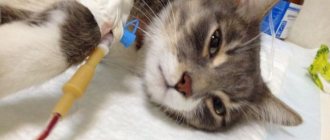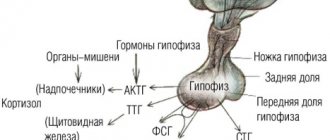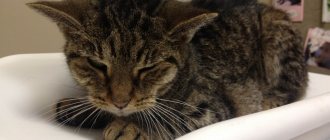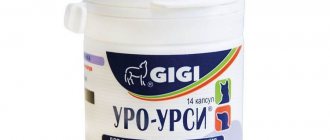It often happens that a cat has kidney stones and kidney failure. This causes severe pain, discomfort when urinating, and difficulty eating. The pet's character deteriorates greatly, which causes a lot of trouble for the cat's owners. The material offered will tell you how to help your pet, how to treat it for a dangerous illness, how to feed it properly, and much more.
What is nephrolithiasis
The kidneys, as you know, are a filtering organ.
Products formed in the cat’s body during metabolism pass through them. Many minerals have low levels of solubility. Small particles of these elements accumulate in the kidneys, first in the form of crystalline sand. Gradually, quite large formations are formed from it in the kidneys - nephrolites, i.e. stones. Kidney stones usually affect cats starting at 6 or 7 years of age. In cats, nephrolithiasis is observed much less frequently.
Very often, purebred representatives of the following breeds suffer from kidney stones:
- British shorthair;
- Persians;
- exotics.
In most cases, the disease is not difficult to treat, and the pet’s health can be restored. Especially if therapy was started in the early stages of the disease.
Signs of disease development
Of course, all lovers of these pets should know what symptoms appear most often in cats with nephritis. Signs of this disease in acute form, in addition to problems with urination, are:
- decreased appetite and depressed state;
- pain when pressing in the kidney area;
- swelling of the eyelids, paws, base of the ears;
- jaundice.
In case of acute nephritis, a sick cat begins to go to the litter box very often. At the same time, the amount of urine she produces decreases.
Chronic nephritis in cats can be preliminarily diagnosed by the presence of symptoms such as:
- frequent “trips” to the tray with large amounts of urine;
- unpleasant ammonia odor from the animal’s mouth;
- apathy;
- vomiting and persistent diarrhea.
The body temperature of a cat with a chronic form of the disease remains normal. The urine of cats with kidney nephritis is usually cloudy and brown or reddish in color. While visiting the tray, sick animals may take unusual poses or make strange sounds.
With nephrosis in cats, among other things, immunity sharply decreases. And this, in turn, can lead to infection of the pet with fungi, viruses or bacteria. Quite often, with nephrosis, anemia is also diagnosed in a cat.
The main causes of nephrolithiasis in cats
Stones, i.e. nephrolites, occur in the kidneys of cats for various reasons. Among them are the following key points:
- infection of the urinary tract and/or kidneys;
- genetic predisposition;
- improper feeding of the animal;
- drinking water of poor quality;
- long-term use of medications to treat other diseases;
- impaired metabolism, i.e. metabolism.
Very often, kidney stones in cats are formed due to a tendency to irregular urination. Another important factor is the formation of urine with a high level of concentration of individual substances. Often, in parallel with nephrolithiasis, cats also develop urolithiasis, i.e. urolithiasis. In this case, stones form in the bladder and urinary system.
Prevention
Considering that the prognosis of nephritis is not always favorable and animals often die due to kidney inflammation or their lives are shortened due to the process becoming chronic, efforts must be made to prevent the occurrence of such a pathology. To reduce the risk of developing such kidney diseases, animals should be given only high-quality feed. When it is not possible to prepare your cat’s food yourself, you need to feed the animal only premium dry food. The pet must have constant access to drinking water.
All cats need physical activity for their health. Low mobility leads to a deterioration in metabolism and the formation of excess fat deposits. You also need to monitor your pet's weight. The animal must be protected from hypothermia. It is necessary to regularly fight fleas and give the cat anthelmintic drugs.
In addition, it is necessary to regularly clean the animal's tray using disinfectants. It is necessary to monitor the cat's health, and if signs of any abnormality appear, you should contact a veterinarian and begin targeted treatment. These measures can reduce the risk of developing inflammatory damage to kidney tissue in cats.
Signs of kidney stones
In order for the treatment of nephrolithiasis in a domestic cat to be successful, it is necessary to recognize the disease in time. Owners should carefully monitor their pet, paying attention to any little details. The main symptoms of nephrolithiasis, i.e., kidney stones, in cats are:
- painful discharge of natural needs;
- blood in urine;
- frequent urination in an unusual place;
- discomfort and/or pain in the abdomen;
- bowel dysfunction;
- frequent urinary tract infections with frequent relapses;
- lack of appetite;
- unnatural weight change (loss or gain);
- refusal to drink water;
- indigestion, vomiting;
- a sharp decrease in physical activity, lethargy, apathy;
- change in the cat’s character and habits;
- frequent manifestations of aggression.
It should be remembered that nephrolithiasis often occurs in cats without any external manifestations or signs. Therefore, your pet needs to be shown to the veterinarian periodically. A specialist will be able to recognize the disease and begin therapy in time.
Duration of treatment
If help is provided to your pet on time and in accordance with all the rules, its nephritis will most likely go away within 7-10 days. Otherwise, the disease will enter an advanced stage and curing the cat will be much more difficult or simply impossible.
Chronic nephritis can last for months in a pet. In addition, this disease is classified as recurrent. This form of pathology in cats, unfortunately, is practically untreatable. That is why, if symptoms of acute nephritis are detected, the animal should be treated immediately. In this case, the disease in cats goes away with virtually no consequences.
Diagnosis of nephrolithiasis in cats
If nephrolithiasis is suspected, the following laboratory tests are performed on a cat:
- general blood test to identify inflammatory processes in the body;
- biochemical blood test to determine kidney parameters and electrolyte balance;
- a general urine test to determine its composition and detect blood in it;
- urine culture to clarify the type of infection and susceptibility to certain antibiotics.
Additionally, a cat with suspected nephrolithiasis undergoes the following diagnostic procedures:
- X-ray of the abdominal cavity to detect nephroliths (kidney stones) and their location;
- Ultrasound to determine the structure of the kidneys and/or urinary organs, determine the number, size, and type of nephroliths present.
In special cases, an X-ray examination is also performed on the principle of excretory urography. Special solutions are introduced into the body, under the influence of which the kidneys produce radiopaque substances. This allows you to thoroughly examine the condition of the kidneys, the size, type and location of the existing nephrolites. At the same time, an examination of the entire urinary system of the cat is also carried out. After identifying the clinical picture and taking an anamnesis, the veterinarian will prescribe the necessary treatment procedures, medications, and diet.
Causes and symptoms of the disease
There are many reasons for the development of inflammatory kidney damage in cats. Most often, such a violation occurs due to the influence of the following unfavorable factors:
- helminthic infestations;
- acute and chronic infectious diseases;
- poor nutrition;
- eating poor quality food;
- chemical poisoning;
- irrational use of drugs;
- injuries;
- burns;
- allergic reactions;
- severe dermatological diseases.
In addition, autoimmune processes occurring in the animal’s body can contribute to the appearance of inflammatory kidney damage. There is also the possibility of a hereditary predisposition to developing nephritis. Some cat breeds are more likely to suffer from inflammatory kidney disease than others.
The symptoms of nephritis depend on the degree of neglect of the pathological process. In some cases, cat owners fail to notice that the animal has a problem, because... the inflammatory process is short-term in nature and its manifestations decrease after the cause of the problem is eliminated. However, if the inflammation affects large areas of the kidneys and persists for a long time, the symptoms become extremely severe. Signs of this pathological condition include:
- loss of appetite;
- decreased mobility;
- oppression;
- swelling of the base of the ears, eyelids and mucous membranes;
- darkening of urine;
- gray-green impurities in the urine;
- vomit;
- strong thirst;
- increased blood pressure;
- increase in body temperature;
- drying of mucous membranes;
- unpleasant odor of urine;
- dyspnea.
In addition, inflammatory damage to the kidney tissue leads to severe pain in cats. Because of this, palpation of the abdomen, as well as the process of urination, can cause a feeling of anxiety in the animal. The cat may meow pitifully. If the organ is severely damaged, the pet stops going to the toilet.
How to treat nephrolithiasis in a cat
Kidney stones are called nephrolites; cats have different sizes, structures, etc. Treatment is selected individually depending on the type of kidney formation and the general condition of the animal.
The main treatment methods used in this case are:
- nephrolithiasis therapy;
- therapeutic diet;
- antibacterial therapy to eliminate infection;
- intravenous infusion therapy to restore the balance of fluids in the body;
- dietary intake to maintain the required pH level and prevent the formation of nephrolites;
- hemostatic drugs to eliminate blood in the urine;
- drugs from the group of antispasmodics to reduce the intensity of pain in a cat;
- physiotherapeutic procedures.
In the absence of specific symptoms and dangerous changes in the composition of urine and/or blood, special treatment is usually not required. In this case, it is enough to provide the cat with dietary nutrition and the necessary care at home. A prerequisite is periodic medical examination in a veterinary hospital. Regular tests and ultrasounds, as well as examination by a specialist, will provide the necessary monitoring of the health of your beloved cat.
Jade in cats: first aid
Providing first aid to a pet excludes the use of medications by the owner, therefore any illiterate use of medications can aggravate the problem.
situation and complicate the course of the disease.
If you observe symptoms indicating nephritis or other diseases affecting the kidneys and genitourinary system, the most important thing you should do is provide your cat with a diet until the doctor arrives. The diet consists of excluding dry food, salty foods, fried foods, and foods high in chemical additives from the diet.
After diagnosis, if necessary, the doctor prescribes the necessary treatment. In some situations, surgery may be required. Always follow your veterinarian's directions. Our center employs only certified specialists who are able to provide quality assistance!
Nephritis in cats: prevention
The only thing better than any treatment is its absence. To avoid the occurrence of diseases, you need to carry out a variety of preventive measures that will help strengthen the animal’s immunity.
- Here are some tips that can help avoid nephritis in cats:
- Monitor your cat's blood pressure;
- give the necessary physical activity to the body;
- avoid hypothermia;
- monitor the quality of food;
- take vitamin complexes;
- visit your veterinarian regularly;
- access to a tray with water should always be available;
- Monitor your pet's hormonal levels.
Removing Stones
In especially dangerous cases, for example, in the presence of very large nephrolites, treatment by surgical intervention is required. During the operation, the cat's kidney is cut with a special instrument and stones (nephroliths) are removed. In some cases, it may be necessary to remove the kidney completely. This method is called nephrectomy.
Surgical intervention is associated with a great risk to the life of a pet. Especially if the patient is severely weakened by illness and age.
After the operation, the cat must undergo a rehabilitation course of treatment and restorative procedures. This is carried out only in a veterinary clinic. Here the cat will be provided with the necessary treatment, food and care.
To prevent recurrent stone formation, the removed nephrolith must be examined in the laboratory. This will help you choose preventive measures to prevent a recurrence of the disease in your cat.
Catheterization
The accumulation of deposits in the kidneys and urinary tract eventually clogs the urethral canal.
If the animal cannot fulfill the need to go to the toilet for a long enough time, despite taking medications, the doctor then decides how to treat kidney stones in the cat. Typically, the result is catheterization.
The procedure involves inserting a special tube into the urethral canal to drain fluid. If the urinary canal is severely swollen and the stones are large, the tube is left in the urethra for several days.
After catheterization, therapy is prescribed to eliminate intoxication, since the body has received poisoning during the period of urine accumulation. To eliminate these consequences, the animal is prescribed a drip.
Diet food
The specific composition of the diet for a cat with nephrolithiasis is determined by a veterinarian nutritionist strictly individually. Pet owners must strictly adhere to the specialist’s recommendations. The basis of the diet for nephrolithiasis is a certain amount of water and special food. You need to give your beloved cat plenty of water. If your pet doesn't drink enough, you need to add water to the food.
Wash and refill the drinking bowl regularly. Drinking water should always be clean and fresh. If the quality of tap water is poor, it must be settled or filtered. You can use non-carbonated mineral water.
It is best to feed a cat with nephrolithiasis ready-made food (dry and/or wet). Natural products should be introduced into the diet only with the permission of a veterinarian. During the first feeding, it is not recommended to mix ready-made food and regular foods.
The basis of the diet is, as a rule, lean meat and/or boiled fish. Eggs, dairy products, cereals - only with the permission of a veterinarian. The feeding regimen must be followed very strictly. The cat should eat the daily ration during 3 feedings. The rest of the time, access to food and feed should be excluded. It is strictly forbidden to feed the cat random foods, food from the common table, or treats. Catching birds and mice should be avoided. Force feeding for nephrolithiasis is unacceptable!
Cat nutrition for urolithiasis
A cat's diet for urolithiasis depends on the type of stones found.
If oxalates are present, it is important to monitor oxalic acid levels. In this case, the following are contraindicated:
- offal (kidneys, liver, etc.);
- calcined products (milk, cheese, cottage cheese).
Your pet's diet should include:
- rice;
- cauliflower;
- beet.
There are also ready-made foods for cats with urolithiasis caused by oxalate stones:
- Hill's Prescription Diet Feline s/d;
- Royal Canin "Urinary S/O LP34";
- Eukanuba Oxalate Urinary Formula.
In the presence of struvite, it is necessary to replace the alkaline reaction with an acidic one. Therefore, a cat should not consume:
- milk;
- cheese;
- cottage cheese;
- egg yolk.
Your cat's diet should include:
- egg white;
- rice;
- oatmeal;
- boiled veal;
- liver;
- beef.
In addition, there are ready-made foods for cats with urolithiasis of struvite origin:
- Hill's Prescription Diet s/d;
- Eukanuba Struvite Urinary Formula;
- Royal Canin "Urinary S/O LP34 Feline".
Important! Ready-made food, even with the appropriate marking, can be given to a pet only with the agreement of a veterinarian. This is especially true for kittens. In addition, even if the acute stage of urolithiasis has passed, the pet must be on a lifelong diet.
Why is nephrolithiasis dangerous?
As kidney stones grow and increase in number, your cat may develop kidney failure. This leads to disruption of metabolic processes, food digestion, etc. As a result, removal of the kidney will be required. In particularly dangerous cases, kidney failure can lead to the death of the animal. Very often, urolithiasis develops as a result of nephrolithiasis. Stones that form in the bladder and urinary tract make it difficult to urinate freely. The cat is in severe pain. Impaired urination and fluid balance in the body causes severe dehydration. Especially in high temperature conditions.
Signs of chronic glomerulonephritis and methods of combating it
Have you been trying to cure your KIDNEYS for many years?
Head of the Institute of Nephrology: “You will be amazed at how easy it is to heal your kidneys just by taking it every day...
Chronic glomerulonephritis is an immunoinflammatory chronic kidney disease that initially affects the renal glomeruli and tubules, subsequently spreading to other kidney tissues. Slowly progressing, damaged kidney tissue is replaced by connective tissue, sclerosis occurs, leading to chronic renal failure.
Kidneys are paired organs that perform the function of urine formation through chemical self-regulation of the body, thereby removing foreign compounds and toxic substances from the body. They take part in carbohydrate and protein metabolism and in the formation of a number of biologically active substances.
The main load during blood filtration falls on the renal glomeruli with tubules and Bowman's capsule (nephrons). At the time of birth, nephrons have already formed, but continue to mature for about 10 years. Since new glomeruli are no longer formed after birth, their loss leads to kidney failure.
Upon completion of filtration, urine is excreted through the renal tubule into the renal pelvis, from where it drains into the bladder.
First of all, with glomerulonephritis, changes occur in the nephrons:
- Due to inflammation, microthrombi form in the glomeruli, which close the space in the vessels. Blood stops flowing into the nephrons. The entire procedure of blood filtration and the formation of primary urine in the affected glomerulus is disrupted.
- Since blood does not flow into the affected vessels, voids form in them, which are replaced by connective tissue. Nephron function declines.
- The more nephrons are involved in the process, the less blood is filtered by the kidneys, and kidney failure appears.
- Kidney failure leads to the accumulation of harmful substances in the body, and beneficial substances do not have time to return to the blood.
Stages
Chronic glomerulonephritis undergoes several stages:
- Compensation stage. This is an early stage in the development of the disease. At this stage, the kidneys are functioning without visible disturbances. There is a moderate increase in blood pressure and slight swelling. A slight increase in protein in the urine, a change in its density, the presence of modified red blood cells. The concentration of urine decreases.
- Stage of decompensation. At this stage, kidney function is impaired and renal failure occurs. Blood pressure numbers are high, the body is poisoned with nitrogenous compounds, and daily urine output increases. The level of protein in the urine increases, the presence of casts and red blood cells increases, and the density of urine decreases.
- Uremia. The most difficult stage. The kidneys cannot maintain the correct composition of the blood. Intoxication with residual nitrogen, creatinine, and urea appears.
Chronic glomerulonephritis can be infectious-immune and non-infectious-immune.
Types of glomerulonephritis:
- Latent glomerulonephritis. The most common type, it accounts for 45% of the total number of patients. Symptoms are mild. Slight increase in blood pressure, mild swelling. The disease can be identified by the results of a laboratory test: protein, red blood cells and white blood cells are increased in the urine. Lasts a long time, up to several decades. Systematic outpatient monitoring of the patient is required. Working capacity is not impaired.
- Hematuric glomerulonephritis is rare, accounting for about 5% of all cases of chronic glomerulonephritis. There is an increased content of altered red blood cells in the urine, which is why the urine is red or pink. Anemia is sometimes observed. Renal failure occurs infrequently, and the course of the disease is favorable.
- Nephrotic glomerulonephritis. It affects 25% of the total number of cases of glomerulonephritis. With this type, the pressure is increased, there is severe swelling, and little urine is produced per day. There is protein in the urine, the density of the urine is increased. In a biochemical blood test, cholesterol is increased and total protein is decreased. This type of glomerulonephritis progresses moderately, but rapid progression is also possible. Kidney failure develops.
- Mixed form of the disease. Occurs in 7% of cases. Repeats the symptoms of hypertensive and nephrotic types. It is characterized by a persistently progressive course and the formation of chronic renal failure.
Any form of the disease has two phases:
- Compensated. The kidneys are working normally.
- Decompensated. The kidneys work with impairment of their functions, chronic or renal failure progresses.
The result of chronic glomerulonephritis is the formation of chronic renal failure. The very first symptom is a decrease in the relative density of urine (isosthenuria) and an increase in the amount of urine excreted per day (polyuria). Diuresis increases at night (nocturia). Signs of uremia appear. The body is poisoned with nitrogenous substances and uremia develops.
Tubulointerstitial nephritis is a disease that is known to a small number of people. According to medical statistics, this disease in most cases affects individuals over 60-65 years of age. Only in 2% of cases is it found in the younger population.
Basic concept
Tubulointerstitial nephritis is a nonspecific disease that affects the liver. A rapidly occurring inflammatory process negatively affects the hepatic soft tissues and its canal passages. If treatment is not started in a timely manner, atrophy is possible. The etiology of this disease varies.
We suggest you read: Inflammation of the lymph nodes in the neck of a cat, treatment. Inflammation of the lymph nodes in cats: causes and forms of the disease
In cats and dogs, symptoms of the disease appear in advanced cases, when 70% of the functional elements of the kidney have already died.
The first symptom is frequent urination. This symptom is not always paid attention to, considering that it is natural, but it is a very formidable symptom, since there is no secondary absorption of water from the kidneys into the bloodstream. To compensate for the loss of fluid in the body, animals begin to drink more.
Signs of uremia: apathy, depression, refusal to eat, exhaustion, dry hair, brownish coating on the surface of the tongue, the presence of ulcers on the tongue and gums, ammonia-like odor from the mouth when breathing. Vomiting, diarrhea and gastrointestinal bleeding appear. Anemia develops. As a result, the animal falls into a coma. In case of development of nerve-paralytic phenomena, the prognosis is 99% unfavorable.
Thus, only timely treatment can save an animal’s life even if the kidney tissue is severely damaged, but treatment must be systematic and supportive. As soon as you stop providing maintenance therapy, the symptoms of the disease will reappear.
Treatment of chronic renal failure should be aimed at improving urination and detoxification. The drug “PHYTOELITA Healthy Kidneys” is absolutely indispensable. The mechanism of action of the drug is determined by the phytotherapeutic activity of biologically active substances from extracts, decoctions and infusions of medicinal plants that have anti-inflammatory, antibacterial, salt-removing, stone-dissolving, restorative, reparative, analgesic and antispasmodic properties.
Medicine "PHYTOELITA Healthy Kidneys":
- has the ability to gradually loosen oxalate and phosphoric acid stones, urates formed in the kidneys and bladder,
- helps regulate the tone of the smooth muscles of the renal pelvis and ureter, which facilitates the process of excretion and removal of stones,
- reduces azotemia in renal failure,
- increases the excretion of sodium and, to a lesser extent, potassium,
- enhances the excretion of nitrogenous substances in the urine.
The drug is used for the prevention and treatment of kidney and urinary tract diseases - acute and chronic renal failure, pyelonephritis, glomerulonephritis, cystitis, urolithiasis and nephrolithiasis as an anti-inflammatory, antibacterial, salt-removing, stone-dissolving, restorative, reparative, analgesic and antispasmodic herbal remedy.
In the treatment of acute forms of diseases, the drug PHYTOELITA Healthy Kidneys is administered orally, one dose every 2 hours for 1-2 days. Then 1 dose 3 times a day until the clinical signs of the disease disappear. The dose of the drug for dogs is one tablet per 10 kg of body weight, for cats and puppies - one tablet per head, for kittens 0.5 tablets per head.
When treating chronic forms of diseases, the drug is given 1 dose 3 times a day. The duration of administration of the drug should be equal to the duration of the disease.
Acute renal failure - its symptoms are similar to those of chronic renal failure - apathy, depression, refusal to eat, dry hair and peeling skin. A brownish coating appears on the surface of the tongue and an ammonia-like odor from the mouth when breathing. Vomiting, diarrhea and gastrointestinal bleeding appear, and anemia develops.
Acute failure occurs in the following cases:
- due to obstruction of the lower urinary tract, due to feline urological syndrome or congenital malformation of the bladder;
- after an abdominal injury, especially combined with a fracture of the pelvic bones, rupture of the bladder or urethra;
- during shock associated with acute blood loss or dehydration;
- after poisoning, especially with antifreeze.
As a rule, all symptoms develop very quickly, and the animal’s condition deteriorates sharply. The prognosis is often unfavorable.
When treating acute renal failure, the goal of treatment is to keep the animal alive until the kidneys are able to eliminate harmful substances from the body.
Treatment is mainly symptomatic:
- replenishing electrolyte deficiency and eliminating dehydration;
- correction of hyperkalemia;
- restoration of kidney function;
- removal of waste that accumulates due to urinary retention.
Folk remedies
For the treatment of nephrolithiasis and/or urolithiasis in cats, an effective remedy is a decoction of corn silk. Dry raw materials for its preparation can be purchased at the pharmacy.
Dry corn silks need to be crushed and pour boiling water in a proportion of 2 tbsp. spoons per 250 ml. Place in a water bath. After 20 minutes, remove the bowl with the broth from the heat and cover with a napkin. Leave in a warm place for at least 60 minutes. Then strain through 3 layers of gauze. Squeeze and add boiled water to the original volume.
The prepared decoction should be given to the cat 3 or 4 times during the day. Single dose - 2 or 3 teaspoons depending on the weight of the pet. The product must be carefully poured into the cat’s mouth from a spoon. Continue therapy for at least 30 days. Then take a break for 15-20 days and repeat the course.











